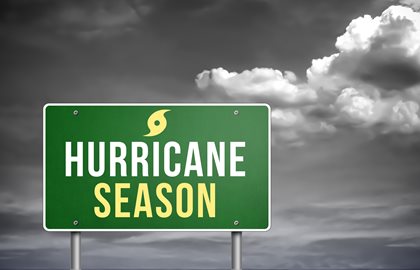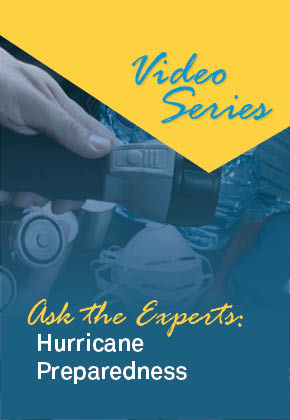Friday August 06, 2021
Hurricanes are a significant risk all across Florida, whether your property is a Miami high-rise, a gated community outside Orlando, or a 55+ community in Boca Raton. Recent tropical storms such as Hurricane Irma in 2017 or Hurricane Michael in 2018 showed that the entire state can bear the impact of a hurricane.
It’s essential for communities in Florida not only to have an effective hurricane preparedness plan in place, but to communicate it effectively to residents, staff, vendors, and all others involved. A clear delineation of action could prevent death or injury, for starters. It could also spare excessive damage, which would save the community money in the long run and protect property values. Insurance claims and premiums may depend on taking the appropriately mandated steps, like boarding up windows securely before the hurricane arrives.
As part of the preparation plan, residents should know who to contact in the case of an emergency. Staff on site should be briefed on what to do to keep anyone on the property safe and protect the facilities during a storm. Vendors should have clear expectations communicated ahead of time for what the association will need in the wake of an emergency.
The strongest plan can come apart with poor implementation. As North America’s property management leader, FirstService Residential knows the importance of clear and preemptive communication. Make sure your entire community is prepared by following these key recommendations.
Communicate plans well before hurricane season
Hurricane season—when tropical storms usually form in the Atlantic Ocean—runs from June to November. These dates give your community a clear timeline on when to be prepared. Emergency preparedness plans must be conveyed well in advance of hurricane season to be effective.When spreading the emergency preparedness plan, make sure to use all the channels of communication available to your community. Only sending it out in one or two mediums increases the chance that some residents will not see the plan or forget how to access it. Utilize your community website, email, your newsletter, text messaging, and association meetings to drive the plan to as wide a net of residents as possible.
Make sure to keep seasonal residents or new members of the community who may be experiencing their first hurricane season in mind. For example, it can help to explain policies about when to put up and take down shutters or when to secure items indoors repeatedly. For residents who may spend part of the year elsewhere, make sure to send out policies ahead of their departure, in February when migration to other parts of the country often begins. Keep in contact with these owners while they are away to help ease stress about their homes.
Craft a reliable system for communicating during an emergency
In the worst tropical storms, communication lines can be interrupted, including the loss of internet or cell service. This makes it all the more essential to have a reliable system of communication in place ahead of any emergency situation. For instance, FirstService Residential Connect includes a mass communication function to help you quickly reach every member of your community quickly, via email, phone, or text. Ask residents to opt-in for texts, which can sometimes still work when other methods fail.As well as outlining how to communicate, it can help to lay out emergency procedures ahead of time. Share disaster relief information, evacuation routes, emergency numbers, and shelter locations and contact information. For any residents with special needs, highlight the Municipal Vulnerable Persons registry. Make clear that management will enter their residences to drain or dry units if need be following the emergency. Also, share any and all information about the insurance process following a hurricane, which can include saving all related receipts in the wake of a storm.
“I found that it’s important to see who is staying behind at the property and if they are okay with management checking in with them regarding the status of the community,” says May Mokdad, regional director at FirstService Residential. “This helped us prepare for after the storm.”
The process or planning how to communicate also extends to property staff. They should be up to speed on how to best contact their supervisor and when to report back to duty after an emergency. Additionally, each staff member should have identification confirming their employment at the property in the case of checkpoints after a hurricane.
Keep communicating throughout the storm
Maintain lines of communication with residents for as long as possible during a storm. Even if members don’t receive messages until after the fact, they let individuals know that the board cared and attempted to reach out. FirstService Residential Connect’s mass communication platform allows these messages to be sent smoothly and quickly. Text messaging is another mechanism to lean on.The board and management should keep in constant communication during an emergency as well. Mokdad shared one story of how this saved a community additional cost.
“At one property, the generator exhaust fan broke because of the winds and we lined the generator company up to come out as soon as the winds subsided enough to do so safely. Of course, the fire alarm went off when the exhaust fan broke and the fumes from the generator set off the fire alarm. This happened right in the middle of the storm!” Mokdad said. “The fire alarm was going off and because I had a copy of the maintenance manual handy, I was able to talk one of the board members through how to reset the alarm from Orlando, even sending him screenshots of what the indicator lights should look like. We also called the fire alarm monitoring company and gave them a heads up on the situation so they didn’t dispatch the fire department when the storm passed.”
One tip from Mokdad is to distribute binders to key personnel with physical copies of employee contact information, a vendor list, any pertinent maintenance manuals, insurance policies, applicable contact details, and an up-to-date resident list including their emergency contacts and details about what assistance they may require during an emergency.
Lean on your management company for resources in the wake of the disaster
After a tropical storm or hurricane, lean on your association’s management company. Since some systems of communication may be down, a management company’s mass communication system will prove invaluable. If power is out or the internet is down, post physical paper notices around the property. Keep out-of-town residents in the loop through digital communications. All residents should be kept abreast of developments, including:- Any warnings, such as elevator outages or notices about drinking water
- Consistent updates about management and board efforts to repair and rebuild any damage or debris
- Handy resources, such as utility contact info or a map of operational stores for goods and services
Once electricity and service are restored, utilize digital communication methods to transmit any urgent messages. This should include SMS messages, email, your community website, social media platforms, and the resident alert system. Your property management company should be able to offer a 24/7 hotline to field questions and resolve issues during emergencies.
“During a recent hurricane, we arranged for another FirstService Residential customer service center, across the continent, to handle all customer service calls for our customers in the Southeast,” says Stephanie Parker, vice president of strategy and operations for FirstService Residential. “Having that resource available meant that, even while local offices were without power, our customers were still taken care of.”
You can expect daily updates from a great property management company, informing the board on the status of the repair efforts and any additional useful updates.
“FirstService Residential’s crisis team created an easy-to-use template for community association managers to use in updating residents about cleanup and recovery efforts,” Parker says. “Communities were provided with information about what happened that day, what was anticipated for the following day and the status of the community, including critical information like grocery stores open nearby.”
Check in with your vendors
Now is the time, before any hurricanes are on the horizon, to outline to your property’s vendors what you expect from them throughout any environmental emergency. This will help open a dialogue, where your trusted partners can convey what they will be capable of providing to assist your community during a disaster. It’s best to be clear and upfront about emergency expectations.For example, establish whether the community’s landscaper has scheduled extra tree trimming during hurricane season. “We were able to give the landscaper a heads up that they would be needed at a particular property immediately after the storm,” Mokdad remembers.
Certain vendors may be based in a mandatory evacuation zone. Knowing this information ahead of time will help manage expectations about what they will be able to deliver in the event of an evacuation order. In those instances, hold conversations to find out if they can deliver supplies before an incoming hurricane or if they can recommend a backup option less likely to have to evacuate.
A comprehensive and robust emergency preparedness plan is essential. So, too, is communicating it clearly to everyone involved, so that every member knows their role. We cannot control the weather, but we can prepare efficiently and effectively for it.

Watch the full video
Is your community association prepared for hurricane season? Access our Hurricane Preparedness video.
Watch now